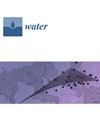A Geophysical-Drilling-Hydrochemical Coupled Method for Accurate Detection of Concealed Water-Conducting Faults in Coal Mines
IF 3
3区 环境科学与生态学
Q2 ENVIRONMENTAL SCIENCES
引用次数: 0
Abstract
The detection of concealed water-conducting structures is essential for preventing water inrush disasters. Aiming to mitigate the limitations inherent in using any single technique, a comprehensive approach that combines integrated mining geophysical exploration, hydrogeological drilling, and hydrochemical exploration (GDH) is proposed for the exploration of concealed water-conducting structures. By conducting a thorough analysis of the background geological data obtained through surface exploration, potentially concealed water-conducting structures can be predicted. Then, a combination of the seismic reflection method (SRM) and mine transient electromagnetic method (MTEM) can be used to detect the location and water-bearing properties of the target structures. Afterwards, the target drilling areas are defined by the anomalies detected by the integrated mine geophysical technique, and the drilling method can directly acquire the hydrogeological information of water-conducting structures and verify the results of the geophysical methods. By means of hydrochemical analysis, inrush water sources and their runoff conditions can be identified, and the spatial relationship betweenof the source aquifers and mining space can be determined; hence, the properties, scale, and configuration of the water-conducting structures can finally be evaluated. Employing a water-conducting fault in a mine as a case study, we verified that the integrated method overcomes the limitations and possible biases of each method, providing a multiple-method solution that can accurately detect concealed water-conducting structures to help prevent water inrush disasters.精确探测煤矿隐蔽导水断层的地球物理-钻探-水化学耦合方法
探测隐蔽的导水结构对于预防涌水灾害至关重要。为了减少使用任何单一技术所固有的局限性,提出了一种综合采矿地球物理勘探、水文地质钻探和水文化学勘探(GDH)的综合方法,用于隐蔽导水结构的勘探。通过对地表勘探获得的背景地质数据进行全面分析,可以预测潜在的隐蔽导水构造。然后,结合使用地震反射法(SRM)和矿山瞬变电磁法(MTEM)来探测目标结构的位置和含水特性。然后,根据综合矿山地球物理技术探测到的异常确定目标钻探区域,通过钻探方法直接获取导水构造的水文地质信息,验证地球物理方法的结果。通过水化学分析,可以确定涌水水源及其径流条件,确定水源含水层与采空区的空间关系,从而最终评价导水构造的性质、规模和构造。以某矿井导水断层为例,我们验证了综合方法克服了每种方法的局限性和可能存在的偏差,提供了一种多种方法并用的解决方案,能够准确探测隐蔽的导水构造,有助于预防涌水灾害。
本文章由计算机程序翻译,如有差异,请以英文原文为准。
求助全文
约1分钟内获得全文
求助全文
来源期刊

Water
WATER RESOURCES-
CiteScore
5.80
自引率
14.70%
发文量
3491
审稿时长
19.85 days
期刊介绍:
Water (ISSN 2073-4441) is an international and cross-disciplinary scholarly journal covering all aspects of water including water science and technology, and the hydrology, ecology and management of water resources. It publishes regular research papers, critical reviews and short communications, and there is no restriction on the length of the papers. Our aim is to encourage scientists to publish their experimental and theoretical research in as much detail as possible. Full experimental and/or methodical details must be provided for research articles. Computed data or files regarding the full details of the experimental procedure, if unable to be published in a normal way, can be deposited as supplementary material.
 求助内容:
求助内容: 应助结果提醒方式:
应助结果提醒方式:


